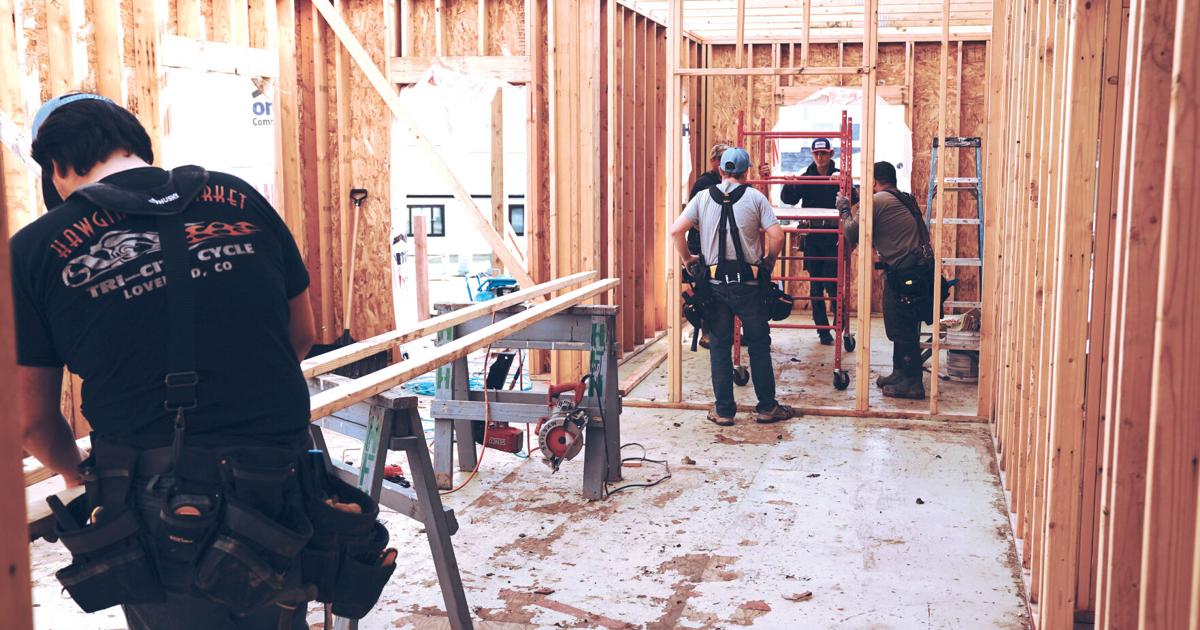
SHERIDAN — For students who like hands-on jobs and seeing their work come together before their eyes, Sheridan High School offers construction and woodworking classes that propel students into a college program or work after they receive their high school diplomas.
Construction courses are part of the career technical education course pathways at SHS, which give students a foothold in the workplace or higher education by partnering with Sheridan College and local business internships.
With approximately 1.5 million people employed in construction, according to the U.S. Bureau of Labor Statistics, there is no shortage of jobs or businesses looking for workers to fill roles.
Students can take three different woodworking classes and two construction classes.
“We really try hard to work with a lot of people in the industry and employers to figure out what they need to know to be able to go to work right away,” said Scott Soderstrom, a construction and woodworking teacher at SHS.
Soderstrom said they cover key topics from safety and job site math all the way to operating computer numerical control plasma cutting machinery. Students learn to create and build cost effective projects that leave behind as little waste as possible, an invaluable skill that takes time to cultivate, Soderstrom said.
Students are able to invest in their own projects and build anything from mini cabin houses, chicken coops, duck and deer blinds or fishing and rifle racks to name a few.
At the end of the course, students can take the Occupational Safety and Health Administration 10 certification test. This is something new that has been recently offered at SHS, Soderstrom said. The 10-hour requirement for this certification ensures a construction worker understands and knows proper safety protocols on a job site to help reduce workplace injuries and fatalities. Since its implementation in 1971, OSHA has helped to reduce workplace fatalities by 66%, according to the OSHA website.
“There’s no shame in going to a trade school. You can make an extremely good living with very little student debt doing that. You can always get a job in skilled labor and we really encourage the ones, the right ones, to go that path,” Soderstrom said.
By the time students reach the end of the course, they can choose career paths in stonemasonry, carpentry, electrical work, plumbing, painting and decorating, and scaffolding demolition work, to name a few. If a student wants to secure a managerial position, then completing a two- or four-year degree would be one of the best paths to take, said Josh Michelena, a construction technology teacher at Sheridan College.
Pursuing a college path can help students become better communicators in the workplace through general education classes they take as part of their degree, Michelena said.
Students at SHS can take dual-enrollment classes — or college classes taken while still in high school — to count toward a certification, overall reducing the cost of college and even shaving off a semester of college. Michelena points out the difference in earning a degree at a two-year institution versus a four-year university is the hands-on skills built into the program and the ability to jump some of the entry-level positions.
“All the technical programs would provide them the technical skills to be able to enter the workforce and be a highly-skilled, entry-level employee compared to someone who just walked out of the door and decided to do that,” Michelena said.
For approximately 13 years, Sheridan College second-year construction students have volunteered their time to Habitat for Humanity of the Eastern Bighorns. Michelena said students help build at least two homes a year and have helped build up to four homes in the past.
“My students are typically out on the job site for Habitat for their labs,” Michelena said. “They build houses just like what the contractors are building. It’s a little bit of a different environment, but they see all the same things they would see at a job site so they won’t be surprised when they go to work on one.”
Completing a house project gives students a competitive edge in their portfolio.
“This year, especially, and even last year, we have a couple calls a week looking for help. Not just from our service areas: there’s people that do an internet search and find our construction program. We get calls from anywhere in the Midwest looking for people,” Michelena said.
In the future, students will work on panelizations and core modulars on the 26-acre lot on Solutions Way, which was undeveloped land donated to the college. Panelization is the process of keeping boards in an array format to help smaller boards stay attached in the larger structure.
The core modular construction refers to building components off-site and transporting the finished product to the building to be used in a structure. Michelena said this is a project area students will be exploring as part of their construction and woodworking classes.








